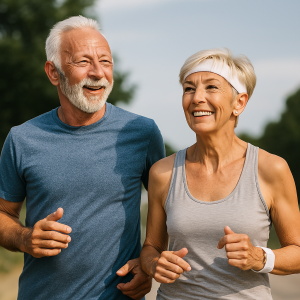Exercise and Its Impact on Aging

Regular physical activity is one of the most powerful tools we have to slow down the aging process. Not only does exercise help maintain muscle mass and cardiovascular health, but it also plays a key role in preserving mental sharpness and emotional well-being. As we age, staying active becomes essential for maintaining independence and quality of life.
Why Exercise Matters More as We Age
1. Maintaining Muscle Mass and Strength
Aging naturally leads to a gradual loss of muscle, a condition known as sarcopenia. Without resistance training, people can lose up to 5% of their muscle mass each decade after age 30. Strength training helps preserve and even rebuild muscle, improving balance, posture, and everyday function.
2. Supporting Heart and Lung Health
Cardiovascular exercise helps keep your heart strong, lowers blood pressure, and improves circulation. Regular aerobic activity can reduce the risk of heart disease, stroke, and type 2 diabetes — common concerns in older adulthood.
3. Boosting Brain Function
Exercise has been shown to support memory, attention, and processing speed. Aerobic movement increases blood flow to the brain, while strength training may improve executive function and mental resilience. Exercise also helps reduce anxiety and depression, promoting emotional health.
Recommended Exercise Types for Older Adults
A well-rounded routine includes four key elements: aerobic (cardio), strength, flexibility, and balance.
Cardio (Aerobic) Exercise
Aim for 150 minutes per week of moderate-intensity cardio. This includes brisk walking, cycling, swimming, or dancing. You can break this up into 20–30 minutes a day, five times a week.
Strength Training
Resistance training 2–3 times per week helps maintain lean muscle and bone density. Use dumbbells, resistance bands, or bodyweight movements like squats and wall push-ups.
Flexibility and Stretching
Daily stretching improves joint health and reduces stiffness. Try gentle yoga, mobility drills, or morning stretching routines to stay limber and avoid injury.
Balance Training
Balance exercises help prevent falls — a major cause of injury in older adults. Stand on one foot, try a wobble board, or practice slow controlled movements like Tai Chi.
Helpful Fitness Equipment from Amazon
Resistance Bands Set with Handles
Ideal for strength training at home, resistance bands are easy on the joints and come in adjustable tension levels. Great for biceps, shoulders, back, and legs.
View on AmazonMini Pedal Exerciser (Under-Desk Cycle)
Perfect for low-impact cardio, this compact bike lets you cycle while seated. Improves blood flow, strengthens legs, and is great for rainy or cold days.
View on AmazonBosu Balance Trainer
This half-dome balance tool helps with stability, coordination, and core strength. Use it for squats, planks, and standing exercises to enhance joint support.
View on AmazonYoga Stretch Strap with Loops
A gentle tool to aid with stretching, this strap helps improve flexibility and posture. Great for warming up, cooling down, or deeper yoga poses.
View on AmazonTips for Staying Motivated
- Start small and build gradually — consistency beats intensity.
- Set achievable goals and track your progress.
- Join a class or find an accountability partner.
- Choose activities you enjoy to stay committed.
It’s never too late to start moving. Whether you’re 60 or 90, regular physical activity has the power to transform how you feel, how you move, and how you age.
 >
>